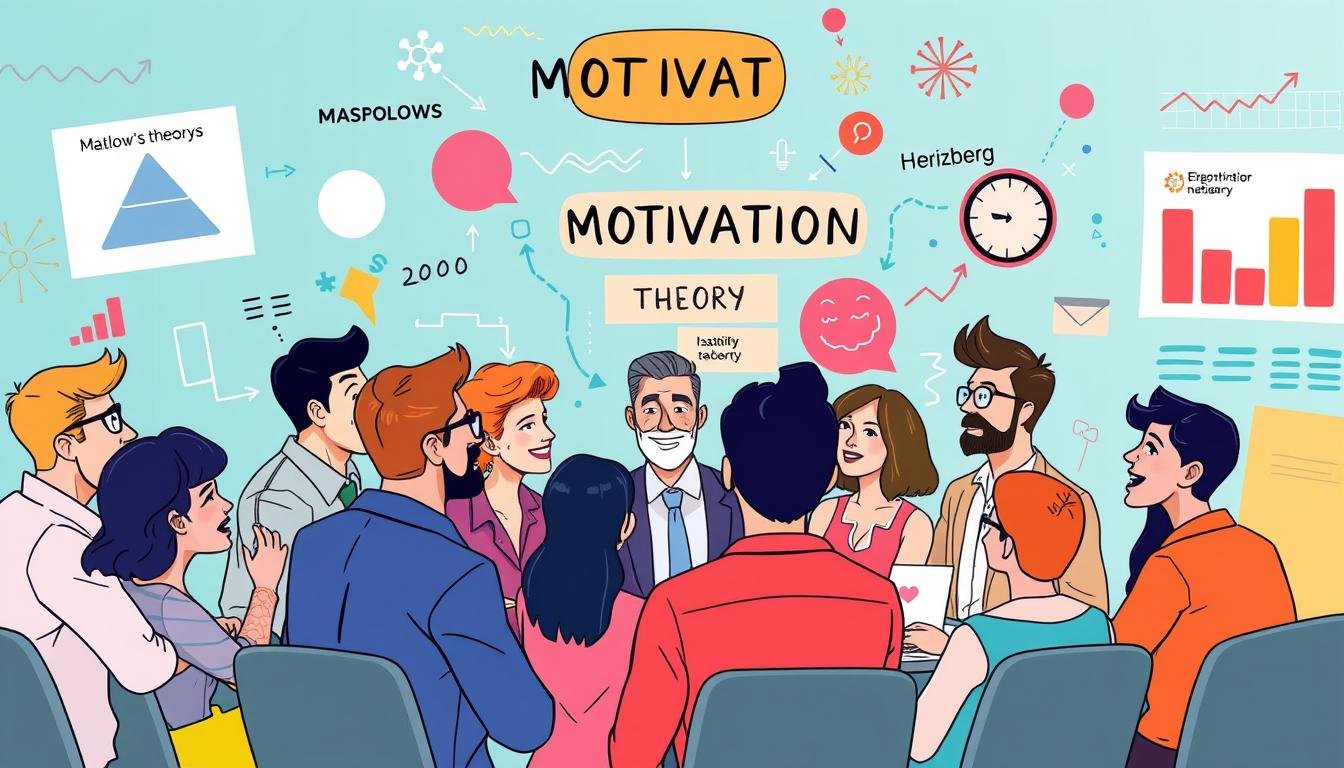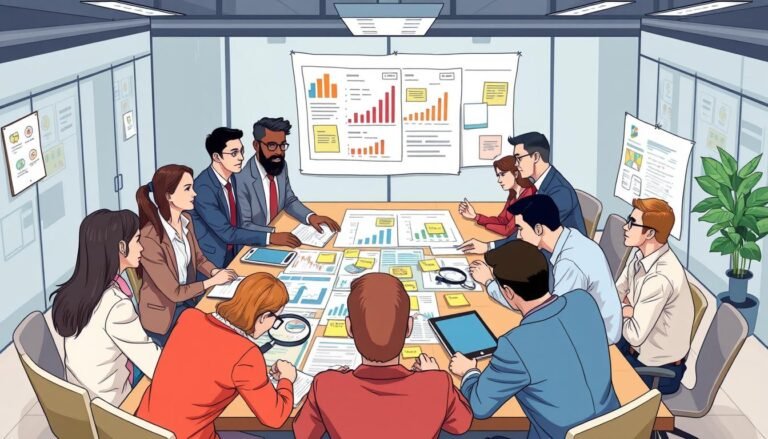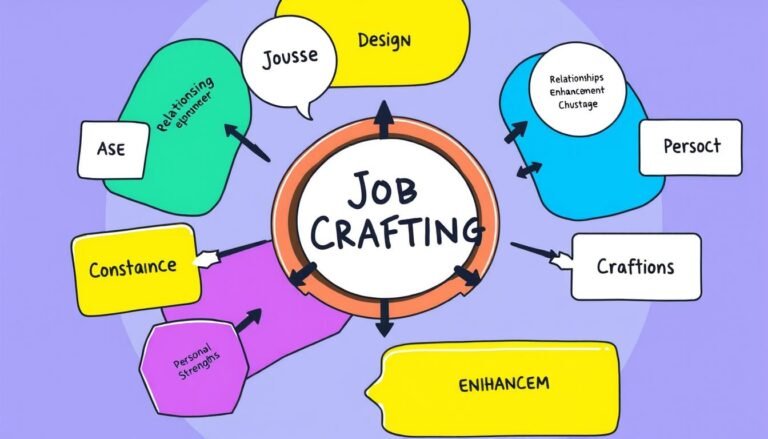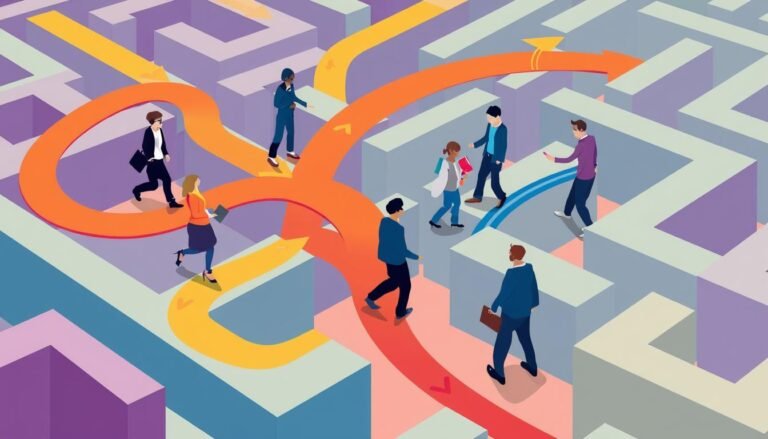Motivation Theories Every Leader Should Know to Inspire Their Team
What makes a team unstoppable? The secret is in understanding motivation theories. These insights into human behavior can change how leaders inspire their teams.
Motivation theories are key to good leadership. They guide leaders in creating a place where employees can grow. By knowing these theories, leaders can motivate their teams to excel.
Frameworks like Maslow’s Hierarchy and McClelland’s Three Needs Theory are very helpful. They show what drives people to do their best. Leaders can use these to meet each team member’s needs.
It’s not just about rewards or punishments. It’s about making a workplace where people feel valued and inspired. When leaders use both internal and external motivators, their team can reach its highest potential.
Key Takeaways
- Motivation theories are essential for effective leadership
- Understanding employee motivation drives business success
- Different theories address various aspects of human motivation
- Tailoring motivation strategies to individual needs is crucial
- Both intrinsic and extrinsic motivators play important roles
- Applying motivation theories can significantly boost team performance
Understanding the Importance of Motivation in Leadership
Motivation is crucial for success in any team. Leaders who understand this can help their team reach their best. Studies show that teams with motivated leaders do better than others.
A Gallup poll found that 60% of workers are not fully engaged. This can hurt a company’s success. But, teams that are engaged are 21% more productive. This shows why leaders must focus on motivation.
Good leaders know that motivation varies for everyone. They use different theories to meet each person’s needs. For example, Maslow’s Hierarchy helps meet higher needs like self-esteem.
“Leadership is not about being in charge. It’s about taking care of those in your charge.” – Simon Sinek
By using both internal and external motivators, leaders can make employees feel valued. This approach boosts individual performance and encourages innovation. It helps the team work towards its goals.
Maslow’s Hierarchy of Needs: A Foundation for Motivation
Maslow’s Hierarchy of Needs is a key concept in workplace motivation. It outlines five tiers of employee needs, starting with basic physiological requirements and progressing to self-actualization. Understanding this hierarchy can help leaders create a more engaging work environment.
Physiological Needs: The Base of the Pyramid
At the foundation are physiological needs. In the workplace, this means fair wages that cover essentials like food, shelter, and rest. Meeting these basic employee needs is crucial for motivation.
Safety and Security in the Workplace
The next level focuses on safety. Job security, clear policies, and a safe work environment address these needs. When employees feel secure, they can focus on higher-level goals.
Love and Belonging: Creating a Sense of Community
Social needs come next. Team-building activities and a positive company culture foster a sense of belonging. This connection to colleagues can significantly boost workplace motivation.
Esteem: Recognition and Respect
Esteem needs involve recognition and respect. Employee appreciation programs and opportunities for advancement satisfy this level, enhancing motivation and job satisfaction.
Self-Actualization: Reaching Full Potential
At the top is self-actualization. This involves providing opportunities for growth and creativity. When employees can reach their full potential, they’re truly motivated.
By addressing each level of Maslow’s Hierarchy, leaders can create a comprehensive approach to workplace motivation. This theory provides a valuable framework for understanding and meeting diverse employee needs.
Herzberg’s Two-Factor Theory: Hygiene and Motivators
Herzberg’s Motivation Theory explains job satisfaction by pointing out two main things: hygiene factors and motivator factors. This theory has greatly changed how managers work and how research is done in many fields.
Hygiene factors help stop job dissatisfaction. They include things like company policies, how well you’re supervised, your relationships with others, your pay, job security, and your work environment. A study in Oman found that 75.3% of healthcare workers were unhappy with their work place, pay, and benefits. This shows how important it is to fix these hygiene factors.
Motivator factors, however, make people happy and help them grow in their jobs. They are things like achieving goals, getting recognized, having chances to move up, taking on more responsibility, and doing meaningful work. In the medical field, good relationships with coworkers and leaders, and chances for professional growth, were found to be key motivators.
| Hygiene Factors | Motivator Factors |
|---|---|
| Company policies | Achievement |
| Supervision quality | Recognition |
| Interpersonal relations | Advancement opportunities |
| Salary | Responsibility |
| Job security | Meaningful work |
It’s key to understand and tackle both hygiene and motivator factors to improve employee happiness and work performance. By focusing on these areas, leaders can make a workplace that prevents dissatisfaction and encourages growth and teamwork among employees.
McClelland’s Three Needs Theory
McClelland’s theory says there are three main emotional needs that drive us. It helps leaders know what motivates their team. This way, they can inspire them better.
Need for Achievement
Those who love to achieve seek tough goals and do well at them. They like tasks where they can take charge and get feedback. These people work well alone and love to tackle new challenges.
Need for Power
People with a strong need for power want to control or influence others. They’re competitive and often good at leading. But, a big need for power can cause problems if it doesn’t match the team’s goals.
Need for Affiliation
Those who value affiliation do best in team settings. They focus on building social connections and getting accepted. They’re great at teamwork but might put relationships first over getting the job done.
| Need | Characteristics | Ideal Roles |
|---|---|---|
| Achievement | Seeks challenges, values personal accomplishment | Independent roles, project management |
| Power | Desires influence, competitive | Leadership positions, management roles |
| Affiliation | Prioritizes relationships, collaborative | Team-based roles, customer service |
Knowing these needs helps leaders create better motivation plans. By figuring out what drives each team member, managers can match tasks and work environments. This boosts productivity and job happiness.
Vroom’s Expectancy Theory: Linking Effort to Outcomes
In 1964, Victor Vroom changed how we see motivation with his Expectancy Theory. This theory, known as VIE, looks at how people decide based on what they think will happen. It’s all about how effort leads to rewards.
- Valence: The value an individual places on a specific outcome
- Instrumentality: The belief that performance leads to rewards
- Expectancy: The belief that effort results in improved performance
This theory says motivation comes from these three parts. When they’re all good, people get more motivated. Leaders can use this to make their teams more inspired.
| Component | Description | Impact on Motivation |
|---|---|---|
| Valence | Perceived satisfaction from achieving a goal | High valence increases motivation |
| Instrumentality | Belief that performance leads to rewards | Strong instrumentality boosts motivation |
| Expectancy | Belief that effort improves performance | High expectancy enhances motivation |
Leaders can use Vroom’s Expectancy Theory to motivate their teams. They should set clear goals, give the right tools, and offer rewards that matter. This way, they link effort, performance, and rewards, boosting motivation and productivity.
Motivation Theories: From Content to Process
Motivation frameworks have changed a lot since the 1940s. They help leaders inspire their teams. These theories are divided into content and process theories. Each gives different insights into what motivates people and how.
Content Theories: Understanding What Motivates
Content theories look at what motivates people. They explore the specific factors that push people to act. Maslow’s Hierarchy of Needs and Herzberg’s Two-Factor Theory are well-known examples.
Process Theories: How Motivation Works
Process theories focus on how motivation works. They study the thought processes behind motivation and behavior. Vroom’s Expectancy Theory and Goal-Setting Theory are key examples.
These frameworks help leaders create environments that boost motivation.
| Theory Type | Focus | Examples | Key Benefit |
|---|---|---|---|
| Content Theories | What motivates | Maslow’s Hierarchy, McClelland’s Needs Theory | Identifies specific motivators |
| Process Theories | How motivation works | Expectancy Theory, Equity Theory | Guides motivation strategies |
Knowing both content and process theories is key for leaders. They can use these frameworks to make strategies that improve team performance and happiness. It’s important to remember that motivation is complex and different for everyone.
Reinforcement Theory: Shaping Behavior Through Consequences
Reinforcement theory, based on operant conditioning, gives leaders tools to change behavior. It shows how consequences affect actions. This helps motivate teams and improve performance.
- Positive reinforcement
- Negative reinforcement
- Positive punishment
- Negative punishment
Managers use these principles in many ways. Raises, bonuses, and promotions are positive rewards. Flexible hours and sabbaticals also motivate. But, demotions or pay cuts punish.
B.F. Skinner suggested a five-step plan for changing behavior:
- Set goals
- Determine reinforcement methods
- Choose procedures
- Implement procedures
- Evaluate and revise
Using reinforcement theory well can bring big benefits. Incentives can lower turnover, boost morale, and improve health. For example, an IT sales team might reward contract closings. This motivates them to reach their goals.
| Reinforcement Type | Example | Impact |
|---|---|---|
| Positive Reinforcement | Extra days off for good performance | Encourages desired behaviors |
| Negative Reinforcement | Stopping tedious tasks when deadlines are met | Motivates through removal of negative conditions |
| Positive Punishment | Demotion for poor performance | Discourages undesired behaviors |
| Negative Punishment | Withholding privileges | Conditions response through removal of positives |
By using reinforcement theory, leaders can create a positive work environment. This environment encourages good behavior and helps teams succeed.
Self-Determination Theory: Intrinsic vs. Extrinsic Motivation
Self-Determination Theory (SDT) explores human motivation deeply. It looks at the difference between intrinsic and extrinsic motivation. Intrinsic motivation comes from within, driven by personal interests and enjoyment. Extrinsic motivation, however, relies on external rewards or pressures.
Studies show intrinsic motivation often leads to better results. Students with high intrinsic motivation do better in school. But, intrinsic motivation often drops as students get older. This decline is linked to less satisfaction of basic psychological needs.
Autonomy: Empowering Employee Decision-Making
Autonomy is key in SDT. It’s about giving people control over their actions. In the workplace, this means letting employees make decisions. When workers feel in charge, they’re more likely to be motivated from within.
Competence: Fostering Skill Development
Competence is another crucial element. People need to feel capable and effective. Leaders can boost motivation by helping team members grow their skills. This creates a sense of mastery and confidence.
Relatedness: Building Meaningful Connections
The final piece is relatedness. It’s about feeling connected to others. In a work setting, this means creating a sense of belonging. When people feel part of a team, they’re more likely to be motivated.
| Motivation Type | Description | Example |
|---|---|---|
| Intrinsic | Driven by internal rewards | Working on a project because it’s enjoyable |
| Extrinsic | Driven by external factors | Completing a task to earn a bonus |
By understanding and applying SDT, leaders can create an environment that nurtures intrinsic motivation. This leads to more engaged, productive, and satisfied team members.
Applying Motivation Theories in the Workplace
Leaders can improve team performance by using practical motivation strategies. It’s important to understand what each team member needs. This helps create a positive work environment.
Employee engagement techniques should mix different motivation theories. Make sure to offer fair pay and job security to meet basic needs. Give challenging work and recognition to fulfill achievement needs.
Effective leadership application of motivation theories can yield significant results:
- Satisfied employees increase productivity by up to 12%
- Only 33% of workers feel engaged, highlighting the need for better motivation
- Highly cohesive teams with strong norms are most productive
To apply these insights, focus on creating a supportive work culture. Give autonomy and help with skill development. Offer growth opportunities and tailor incentives to individual preferences.
Regular feedback and assessment of motivation levels are crucial for success.
| Motivation Theory | Practical Application |
|---|---|
| Maslow’s Hierarchy | Address basic needs before higher-level ones |
| Herzberg’s Two-Factor | Improve both hygiene factors and motivators |
| McClelland’s Three Needs | Cater to achievement, affiliation, and power needs |
| Vroom’s Expectancy | Link desired outcomes to specific behaviors |
By applying these theories thoughtfully, leaders can create a motivated, engaged workforce. This drives organizational success.
Conclusion: Harnessing Motivation Theories for Effective Leadership
Leadership is all about knowing and using motivation theories. This helps leaders make workplaces that inspire and keep teams engaged. Such environments lead to better team performance and happier employees.
Studies show motivation’s big role in the workplace. Companies with positive cultures keep employees 20% longer. Work-life balance policies boost morale by 25%. These facts show how motivation affects team work.
Leaders who get motivation right can make big changes. Giving employees freedom boosts productivity by 25%. Clear paths for career growth reduce turnover by 15%. Recognizing employees’ hard work increases satisfaction by 30%. These numbers show motivation is essential for success.
To be a great leader, always keep learning about motivation. Adjust strategies as needed and track their success. This way, leaders can make workplaces where everyone succeeds, leading to better productivity and success for the whole organization.
Source Links
- Top Theories of Work Motivation Every Leader Should Know | Poppulo
- Top 10 Leadership Theories in 2024
- Leadership: Theories of Motivation
- 5 Motivation Theories for Managers – Work Life by Atlassian
- Leadership and Motivation: Exploring 10 Theories of Motivation
- Maslow’s Hierarchy of Needs
- How Maslow’s Hierarchy of Needs Explains Human Motivation
- Herzberg’s Two-Factor Theory Of Motivation-Hygiene
- Herzberg’s Motivation-Hygiene Theory: Two-factor – Education Library
- The application of Herzberg’s two-factor theory of motivation to job satisfaction in clinical laboratories in Omani hospitals
- McClelland’s Three Needs Theory: Power, Achievement, and Affiliation – Education Library
- McClelland’s Acquired Needs Motivation Theory – The World of Work Project
- McClelland’s Theory Of Needs And Motivation – Applications
- Victor Vroom’s Expectancy Theory of Motivation
- Vroom’s Expectancy Theory of Motivation: Definition, Principles & Uses
- Motivation Theories: Content and Process – The World of Work Project
- Theories of Motivation: Content & Process Theories – Highrise
- Content Theories Of Motivation
- What is the reinforcement theory of motivation?
- Skinner’s Reinforcement Theory in the Classroom
- Reinforcement Theory | Introduction to Business
- Microsoft Word – Ryan and Deci CEP Pre-Print.docx
- Self Determination Theory and How It Explains Motivation
- Top 5 motivation theories to use in the workplace
- How to Use Motivation Theory as a Team (Theory + Application)
- What Are The Best Motivation Theories For Employers in 2024? | Vouch
- Harnessing the Power of Employee Motivation Theories
- Motivating Change: a grounded theory of how to achieve large-scale, sustained change, co-created with improvement organisations across the UK
- Leadership Theories and Styles







